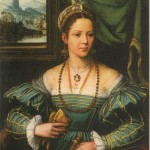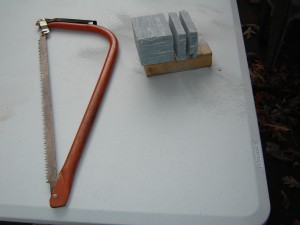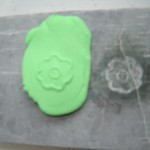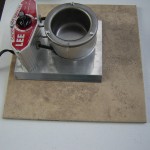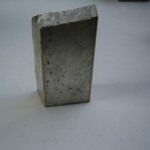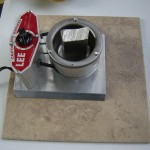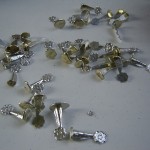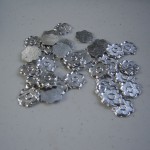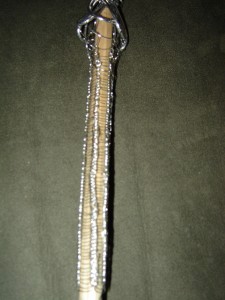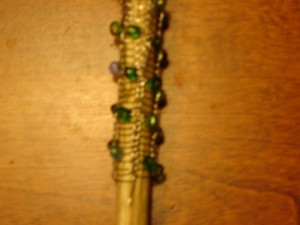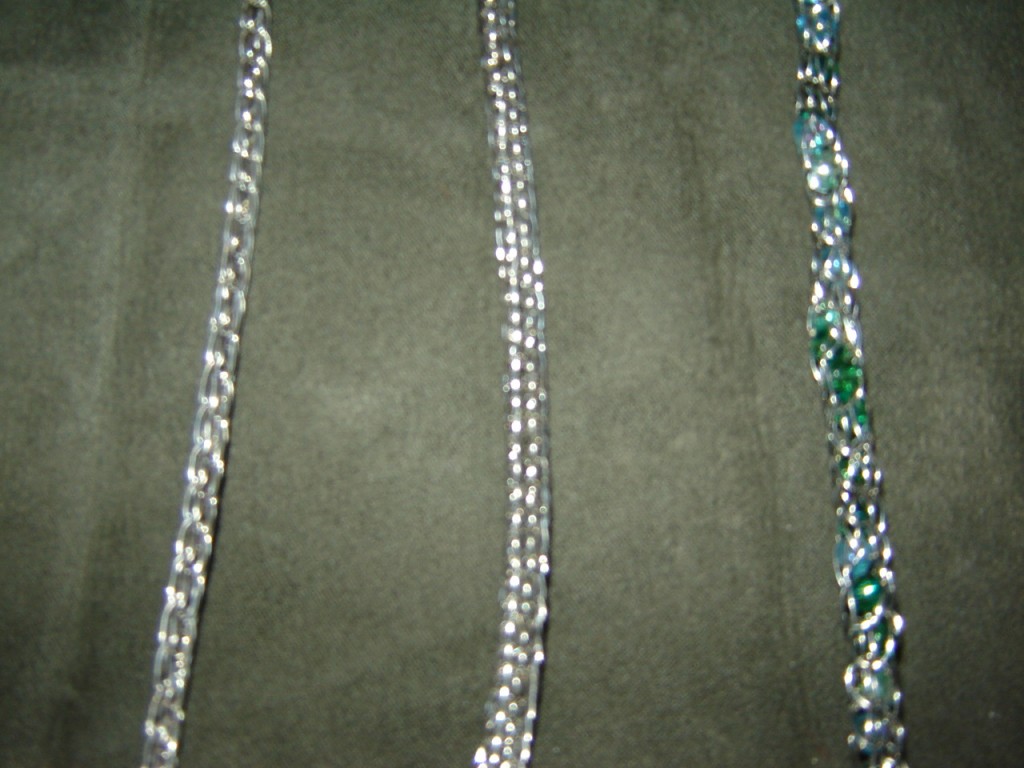I started this research project looking for the historical authenticity of what I was taught as “Viking Wire Weaving.” While a google search provided many hits, most were tutorials and how to-s for this popular wire chain work. I finally came across a few blogs and research papers, notably all SCA, that were also looking into the history of the craft. The majority pointed to a 2001 SCA research project “A Research Journey: Trichinopoly Chainwork Is It Viking Chain Knitting” by Lady Apollonia Voss.
The crux of the historical authenticity argued by this paper rested largely on Graham-Campbell’s description in The Viking Age Gold and Silver of Scotland (AD 850-1100) of a “Trichinopoly chain,” found in a 9th century hoard. Now I had a better term to search with: Trichinopoly. However, as I searched for more information on this new label, I became more and more concerned about its origins. The British Museum has a piece labeled as trichinopoly chainwork, but all other references seemed to point to an Imperial British term for a region of colonial India. Could “Viking Wire Weaving” really carry a title that referenced 19th century India?
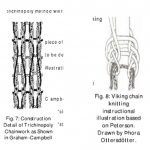 Putting that aside for later research, I delved into the woven patterns identified in A Research Journey only to discover another stumbling block. The reliance on Graham-Campell’s authenticity of the chain work hinges on a perceived similarity between A Research Journey‘s Figure 7 and Figure 8. To my eye, a significant difference comes with the twist depicted in Figure 8. Figure 8 represents a better depiction of what I was taught as “Viking Wire Weaving,” where the wire crosses over itself to form each loop. The pattern in Figure 7 shows a continuous wave pattern with no twists or cross over (follow the darkest thread). This seemed to answer the question; No, Trichinopoly was not Viking Wire Weaving. But then, was Viking Wire Weaving historically accurate?
Putting that aside for later research, I delved into the woven patterns identified in A Research Journey only to discover another stumbling block. The reliance on Graham-Campell’s authenticity of the chain work hinges on a perceived similarity between A Research Journey‘s Figure 7 and Figure 8. To my eye, a significant difference comes with the twist depicted in Figure 8. Figure 8 represents a better depiction of what I was taught as “Viking Wire Weaving,” where the wire crosses over itself to form each loop. The pattern in Figure 7 shows a continuous wave pattern with no twists or cross over (follow the darkest thread). This seemed to answer the question; No, Trichinopoly was not Viking Wire Weaving. But then, was Viking Wire Weaving historically accurate?
However, all was not lost! Additional support for historical authenticity was discussed using Tomantera’s publication Braid, Weave, and Foxtail. An InterLibrary Loan request yielded a wonderful description of three, visually related chains. The “braid” described makes the looping pattern (top) and the “interweave” making the lower wave pattern as seen to the right (the “foxtail” pattern being loop-in-loop chain). Tomantera also provided descriptions of each technique, something 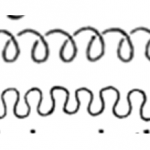 Graham-Campell did not. The “braid” or looped pattern is made with a basic unit of a 1.2-1.5 meter length of wire. As each loop requires that the free end be drawn through the braid this is the maximum working length due to metal fatigue. Additional 1.2-1.5m sections are then added to make the final product the desired length. This sounds exactly like the Viking Wire Weaving I was taught in the SCA. Interweaving or the waved pattern, on the other hand, uses one long continuous wire. Both techniques produce a hollow tube, that is then pulled through a draw plate, creating a smaller diameter for the final, tightly knit appearance.
Graham-Campell did not. The “braid” or looped pattern is made with a basic unit of a 1.2-1.5 meter length of wire. As each loop requires that the free end be drawn through the braid this is the maximum working length due to metal fatigue. Additional 1.2-1.5m sections are then added to make the final product the desired length. This sounds exactly like the Viking Wire Weaving I was taught in the SCA. Interweaving or the waved pattern, on the other hand, uses one long continuous wire. Both techniques produce a hollow tube, that is then pulled through a draw plate, creating a smaller diameter for the final, tightly knit appearance.
This then seemed to be the sticking point: while admittedly similar in final appearance, Graham-Campbell’s Trichinopoly compares to Tomantera’s interweave… not to the braiding technique. However, it is the braiding technique (the top looping pattern) that matches A Research Journey‘s Fig 8, and the “Viking Wire Weaving” I was taught.
So, back, Graham-Campbell. As it happens, A Research Journey‘s Fig 7 attributed to Graham-Campbell was actually produced by a predecessor: David Wilson and C.E. Blunt. In their publication The Trewhiddle Hoard I found the full description. “The chainwork… is manufactured in the Trichinopoly technique, a method of circular plaiting (known as tatting) still in use among school-children in England. The chain is plaited on nails through a hole bored in a piece of wood; the resulting pattern is illustrated in fig 4” (Wilson & Blunt 1961). Note, Wilson & Blunt Figure 4 is the same image labeled Figure 7 in A Research Journey (see above). So the Trichinopoly technique is actually tatting!
Now this part took some work. There are two types of tatting: needle and shuttle. Google searching for how to-s, patterns, instructions, etc. did not yield any patterns related to the Wilson & Blunt image. It wasn’t for several months, and many SCA conversations that a thought finally struck me… what about that “lazy knitting” technique my grandmother used to make pot holders… and behold; it comes out looking exactly right!
Final conclusions: While both are in fact period chainwork… “Viking Wire Weaving” and “Trichinopoly” are NOT the same! And as an additional aside the “Trichinopoly” label is NOT a period reference. However, as Tomantera (among others) reveals, both techniques are period in origin. But I’ll get more into that later…
So a couple of final thoughts: I wanted to get this basic outline out. I also wanted to have a place I could point to images and show people what I had been trying to explain for months. This is not a final draft. I have more… I have lots more about the history of the “Trichinopoly technique” (still period, but not Viking); the history of “Viking Wire Weaving”- yes it is Viking, it’s just not “Trichinopoly”; and the origin of the label “Trichinopoly”- and why, being a 19th century reference, would ever have been applied in the first place.

